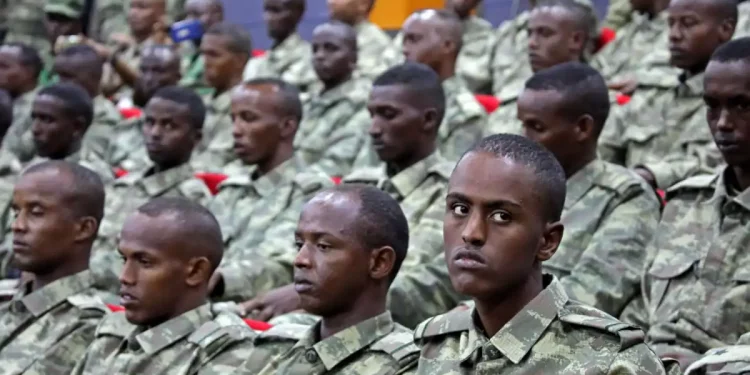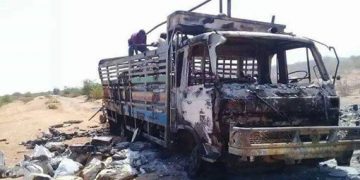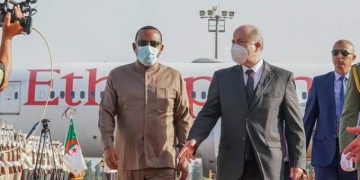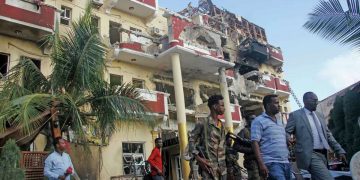A new report reveals Somali soldiers were directly involved in the Tigray genocide in Ethiopia, in a war that left thousands of people dead despite efforts by the international community to call for a ceasefire.
For the last 13 months, the Tigray Defense Forces [TDF] have been at loggerheads with the Ethiopia National Defense Forces [ENDF], with external factors also shaping the war, which has been blamed on the government of Ethiopia.
According to the Globe and Mail, several eyewitnesses confirmed that Somali troops worked closely with Eritrea counterparts in unleashing innocent civilians within Tigray when assisting ENDF to regain grounds within the country.
This report corroborates accounts given by the United Nations Special Rapporteur to Eritrea, who said Somali troops training in Asmara crossed over to Tigray, particularly in Axum, where they killed hundreds of residents.
Ethiopia had reportedly asked for military support from Eritrea and Somalia to help crush the Tigray rebels. Tigray rebels fell out with the Ethiopian government after Prime Minister Abiy Ahmed took over the helm in 2018.
Despite the reports, Asmara, Addis Ababa, and Mogadishu have repeatedly denied the reports, arguing that the war has only involved TDF and ENDF. Initially, Somalia had dismissed claims that her soldiers were training in Eritrea only to admit after pressure from public members.
But The Globe’s investigation has provided, for the first time, extensive details of civilian killings committed by Somali soldiers allied with Eritrean forces in the region. There are close to 5000 Somali soldiers in Eritrea.
According to Gebretsadik, a 52-year-old farmer from the village of Zebangedena in northwestern Tigray said, the dusty roads of his town were strewn with the bodies of decapitated clergymen in December 2020, a few weeks after the beginning of the war, the Globe and Mail reports.
Those who died, he says, were priests and monks he recognized. He further says troops of Somali and Eritrea participated in the atrocities besides capturing some villages. Their uniforms were recognizable.
“They slaughtered them like chickens,” he told The Globe.
The old man notes that the Somali and Eritrean troops stayed in the region until February 2021 before leaving. He often hid in bushes to escape from the attacks waged by the foreign forces.
The Globe talked to dozens of survivors who had witnessed atrocities in six Tigrayan villages where Somali troops had been stationed between early December 2020 and late February 2021. The Globe is not publishing their full names or current locations because their lives could be in danger.
Survivors told the Globe and Mail that the Somali soldiers were wearing Eritrean military gears while invading the region and would be easily identified through their physical outlook. Unlike the Eritreans, they could not speak any Tigrinya, the language spoken in Tigray and much of Eritrea. The witnesses said they also heard the Eritrean troops referring to Somalis.
Garowe Online had first reported that dozens of Somali soldiers had been killed in Tigray, but the government vehemently denied the claims. Later on, the government admitted that close to 2,500 soldiers were training in Eritrea.
Up to 10,000 Somali troops were deployed in Tigray, according to current and former Ethiopian officials who spoke to The Globe. The Globe is not identifying the individuals because they face the threat of reprisals for their comments.
“They showed no mercy,” said Berket, a 32-year-old farmer in the Tigrayan village of Mai Harmaz. “The Eritreans interrogate you before they kill you. But the Somali troops were full of contempt for that.”
One of his neighbors, a 76-year-old priest, was among those killed by the Somali troops, he said. Kibrom, a 37-year-old man who fled the village of Hamlo in January, said the beheadings by Somali troops became an “everyday reality” in his town.
“The churches were inhabited by the troops,” he said. “They burned the holy books and sacred objects. As a result, churches became the most unsafe places. Villagers stopped going to churches because the Somali troops would kill anyone they found in churches.”
Reports indicate that the soldiers crossed over from Eritrea, training before invading Western Tigray. Although their target was TDF, they ended up killing innocent civilians.
“They undoubtedly have participated in the war,” said Gebremeskel Kassa, chief of staff in the interim administration in Tigray that the Ethiopian government appointed after seizing control of the region in the early months of the war. He later fled abroad, fearing for his safety when Ethiopian officials criticized him for Tigrayan military gains in the area.
Mr. Gebremeskel said he knew about the Somali deployment from his travels in Tigray and his private meetings with top Ethiopian officials and military generals.
“All of us who were top officials knew of that,” he told The Globe. “The Somali troops took training in the Eritrean camp of Sawa due to a military deal between the three governments before the war started.”
Eritrean President Isaias Afwerki, the authoritarian ruler of his country for nearly three decades, is a crucial player in the three-country alliance. “He sees this as an opportunity to reshape the whole of the Horn of Africa in his direction,” said Martin Plaut, a British-based Eritrea expert and commentator.
“Getting these Somali troops involved was just the first installment of this much longer, much more important relationship that he was trying to build in which he would be the king, with allies both in Somalia and Ethiopia,” Mr. Plaut told The Globe.
“He has pursued his ambition of destroying the Tigrayans since the 1970s. To achieve his ends, he would like to establish a transnational relationship in the Horn that allows the individual states to exist, but to support each other while crushing local movements.”
Top officials at Villa Somalia are said to have lured young men recruited from different parts of Somalia into going to work in Doha as security guards at the 2022 FIFA World Cup.
But the youths found themselves in military training camps in Eritrea and in late 2020 they were taken to the Tigray region then forced to fight there along with Eritrean and Ethiopian troops, according to sources.
After their mass recruitment, the 1st group was dispatched to Asmara from Mogadishu in Aug 2019 and the deployment continued until 2020, said a military officer who spoke to Garowe Online on condition of anonymity.
The soldiers are estimated to be from 3,000 to 7,000 and they were trained in at least 4 camps in Eritrea. UN report revealed that the soldiers have been spotted in Aksum, northern Ethiopia during the conflict.
Since the news surfaced, the Somali government has been under growing pressure to explain the fate of soldiers whose families fear they were secretly deployed from training camps in neighboring Eritrea to fight in Ethiopia’s northern Tigray region, where most of them were reportedly killed.
The government has strenuously denied allegations that Somali troops were sent to battlefields in Tigray, where Ethiopian federal troops have been fighting with regional forces since November.
GAROWE ONLINE
Sign Up For Our Newsletter
Subscribe to our mailing list to receives daily updates direct to your inbox!








